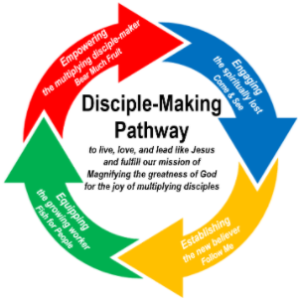
What is Our Method? A Discipleship Pathway

Several years ago, my family took a trip from Atlanta, GA to Charleston, SC to vacation at the beach. As we got in the vehicle, I set my GPS to the address of where we would be lodging. Fortunately, while in route, the GPS redirected us to avoid a major delay due to a vehicle accident. Rather than sitting for hours, it warned us and suggested a better route.

I easily remember the days before GPS when we would use the old Rand McNalley maps. Though the maps were great tools with accurate information, it simply couldn’t help avoiding traffic delays or road closures.
Without a clear direction and a right perspective, we would have wandered for hours, perhaps even days, without getting anywhere desired and being left frustrated. This leads me to consider the church. If magnifying God and multiplying disciples is what the church is about, there must be a clear discipleship pathway that clarifies how the church will accomplish the mission. Without clarity, time will be wasted, and the church will be unable to know if or when disciples have been made.
In the New Testament, there are four stages that have been identified as the pathway to spiritual growth.
The first stage is to engage the spiritually lost. This method of Jesus is called, “Come & See” as found in John 1:39. When Jesus approach various people, He called them to come and see who He is and what He is about. Before ascending to Heaven, Jesus also commanded the followers of Christ in Matthew 28:19, “Go… make disciples.”
People are spiritually dead from birth. As followers of Christ engage the spiritually lost, they show and share the gospel. Their greatest need is the gospel, so it is wise to be prepared to give answers to questions and serve them as a friend. Here is where a prayer, care, and share approach works well. Just as Dr. Jerry Falwell Sr. has famously said, “Nothing of eternal significance ever happens apart from prayer.” The goal in prayer, care, and share is to see the Hoy Spirit open their minds and hearts to salvation.
As a church, we can commit to hosting “Come and See” events. These can include a VBS, Fall Festival, Easter Egg Hunt, Easter service, Christmas Eve Service, Community Day to honor all local teachers, police, firefighters, medical professionals, and public servants. As individual households, consider hosting block parties, game nights, and other special events to invite lost neighbors to your home giving opportunities to share and share the gospel of Jesus.
In addition to “Come and See,” Jesus had a “Go and Tell” strategy to engage the spiritually lost. This is where we can to door-to-door visit, partner with the local public schools, and have Servant Evangelism Days in the community giving away water bottles, Mother’s Day Carnations, Free car wash, etc.
The second stage is to establish the new believer. Jesus’ method was to command people to “Follow Me” as found in John 1:43. After seeing and trusting Jesus as Lord and Savior, the new believers follow in His footsteps to learn from Him as their model. According to Colossians 2:7, Christians are to “walk in Him, rooted and built up in him and established in the faith, just as you were taught, abounding in thanksgiving.” New believers are like infants and children in the faith. The goal is to help them grow up healthy in the faith. In simple terms, a new believer needs grow just like a physical infant and child. He will need to learn to identify, breathe, feed, talk, and walk. First, a new believer learns to identify as a child of the King being adopted into the family of God. Just like a newborn infant, a new believer must learn to breathe, exhaling by confessing sin and inhaling by receiving God’s forgiveness. They must also learn to feed on the milk of God’s Word and hearing biblical teaching. As a spiritual child grows up, they learn to talk by sharing God’s Words and their testimony of what God has done for and in them. Also, a new child of God will learn to walk in step with the Holy Spirit by prayer, worship, obedience, and in godly relationships.
The third stage is to equip the growing worker. Jesus challenges His followers to “Fish for People” as recorded in Matthew 4:19. This reveals the necessity of sharing the gospel and representing Jesus in this world. In Ephesians 4:12, Paul instructs the church leaders “to equip the saints for the work of ministry.” This third stage is like a young adult having learned the elementary teachings and now ready to step out and be a servant leader. The goal is to equip this growing believer to serve based on God’s giftedness in them. This teaching will be more of the meat of the Word of God both in content and opportunity to serve. A growing believer will excel as they learn their spiritual gifts, begin serving in areas of gifting, and being challenged to share the Gospel with those in need.
While many churches are declining in number, a few are seeing the Lord’s blessing by adding a few people every year. While this is good, I believe the power of the Lord allows for multiplication that is “bearing much fruit.” Adding 10 people a year to a church is good, producing 100 people in a decade. But what if even a quarter of the church members began to make disciples, then the results would be far greater in a decade. For example, suppose a church of 100 people was able to get 25 of the members reaching and discipling 1 person a piece. Then, after 2 years of discipleship, the original 25 people along with the newly discipled 25 reached and discipled 1 person a piece, continuing the same cycle. Within the same decade as the church that merely added 100 people, there would be over 800 people multiplying disciples.
Read more...

